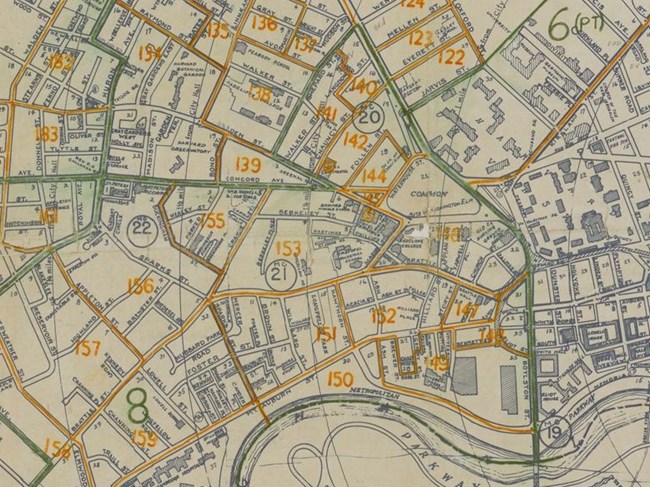Last updated: April 7, 2022
Article
105 Brattle in the 1950 Census
On April 1, 2022, the National Archives released the population schedules for the 1950 US Census. What can this document, listing all of the residents of the United States block by block, tell us about the house at 105 Brattle Street?

National Archives and Records Administration
Finding the right page in the census was straightforward. Knowing the exact street address meant it was simple to look up the Enumeration District number – the footprint of the house even appears on the Enumeration District map for ED 17-153!
18 pages into the schedules for this district, we find eight adults and two children living at 105 Brattle Street, in apartments 1 and 2, enumerated in person by Daniel Driver on April 7, 1950.

1950 Census, ED 17-153, page 18. National Archives and Records Administration
Some names are familiar and expected: Henry W.L. Dana, a 69 year-old historian (working 60 hours a week!) lodges in the portion designated Apt. 2. Dana, the grandson of the poet Henry Longfellow, scholar, preservationist, and educator, would die just 19 days after the census taker’s visit.
“Apartment 2” includes five other lodgers, some of whose names are less familiar:
- Kamolkan Ekasagdi, a 26-year-old woman born in Siam, engaged in “Other” than paid work. A hunch that she was a student is borne out by a separate journal search yielding the title of her doctoral dissertation, completed in 1953 at Columbia University: “A Proposed Plan for the Implementation of Professional Laboratory Experiences in the Preservice Secondary Teaching Program of the Division of Education, Royal University, Bangkok.”
- Ann L. Minturn, a 21-year-old woman from Illinois, working as a research assistant at a private university. Because she landed on a supplemental line, we also learn that in 1949 she lived in South Hadley, MA, and earned $860 for 27 weeks of work. In 1950 she was attending school as a graduate student. The annual catalog for Mount Holyoke College confirms that Minturn was in the college’s class of 1949. A student directory confirms that while living at 105 Brattle Street, Minturn was a graduate student at Radcliffe College, with a home address at the Maryland School for the Blind. (Minturn would earn her M.A. and Ph.D. degrees in social psychology from Radcliffe and become a scholar of women's and children's issues with a cross-cultural focus on India.)
- Myra C. Hill, a 75-year-old widow, is crossed out and noted as also counted in Norfolk County. Reading under the line, however, we learn that she was working for a church organization, processing clothing.
- Richard H. and Betty M. Ash, a young couple from Ohio, are a pair of familiar names – the site’s research collection includes Richard Ash’s recollections of his time lodging in the house while a student at the Episcopal Theological Seminary next door. The census confirms his occupation – a student assistant at a church – and adds that his wife worked as a floor secretary at a private hospital. The Ashes had just moved into the house – in February 1950 – when the census was taken, and would welcome their first child later that year.
Tom and Rosemary Edwards occupied “Apartment 1” with their two daughters, Rosemary (4) and Lacy (1). Like Richard Ash, Tom Edwards prepared for the ministry at the Episcopal Theological Seminary next door on Brattle Street and had been ordained in 1948. Rosemary’s supplemental questions add that she completed five years of college education, and in 1950 stayed at home. The Edwards family moved into 105 Brattle Street around the time their first child was born in 1946.
The US Census provides a snapshot of the house’s residents on a particular day – April 7, 1950. Taken with Richard Ash’s recollections, shared decades after his residence at the house, they add names and clues to people he remembered with sketchy details. In turn, Ash’s recollections add information about where these ten people lived in the house, how they interacted, and the four non-resident staff members.
Hill, Minturn, and Ekasagdi lived in the attic and used the kitchen. Mrs. Hill – “a great grandmother 27 times” volunteered at the Quaker Center at Longfellow Park. Ash remembered Kamolkan Ekasagdi only as “the Siamese princess,” and remembered the scent of curry in the kitchen when she cooked.
The Ash family occupied the second-floor chambers on the west of the house – the “Gold Ring Room” and the small “maid’s room” behind it, where they put the baby’s crib – and the Edwards family occupied the second-floor chambers on the east side. Harry Dana occupied the second-floor rooms of the back ell, as he had off and on since 1917. Ash recalled Dana and his cousin Anne Thorp treating him like family, but that Tom Edwards despised and rejected Dana because he was gay.
The staff – Frank Buda, Thomas de Valcourt, Mr. Gaffney, and Mrs. Connolly – worked at the house, maintaining the house and grounds, providing access to researchers, and offering regular public tours of the first floor.
In 1950, the Longfellow House was a busy place, filled with family life, graduate student’s studies, public visitation, and historic preservation work. As captured in the census’s snapshot, ten people, ages 1 to 75, lived on the second and third floors of the house, with diverse backgrounds, interests, and stories. The document provides one more window into the 20th century legacy of preservation of the house, under the stewardship of Harry Dana and the Longfellow House Trust.
